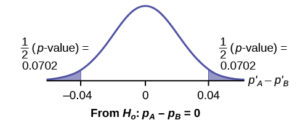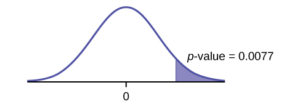Hypothesis Testing with Two Samples
37 Comparing Two Independent Population Proportions
In this chapter, we learn how to conduct a hypothesis test in order to compare two population proportions, which we refer to as $p_1$ and $p_2$. To conduct the hypothesis test, we calculate two sample proportions, which we refer to as $\hat p_1$ and $\hat p_2$. Each sample proportion is the result of underlying binomial trials. If the sample 1 has $x_1$ successes in $n_1$ trials, then the resulting sample proportion is $\hat p_1=\frac{x_1}{n_1}$. Similarly, $\hat p_2=\frac{x_2}{n_2}$ for $x_2$ successes in $n_2$ trials.
When conducting a hypothesis test that compares two independent population proportions, the following characteristics should be present:
- The two independent samples are simple random samples that are independent.
- The number of successes is at least five, and the number of failures is at least five, for each of the samples.
- Growing literature states that the population must be at least ten or 20 times the size of the sample. This keeps each population from being over-sampled and causing incorrect results.
Comparing two proportions, like comparing two means, is common. If two estimated proportions are different, it may be due to a difference in the populations or it may be due to chance. A hypothesis test can help determine if a difference in the estimated proportions reflects a difference in the population proportions.
The difference of two proportions follows an approximate normal distribution. Generally, the null hypothesis states that the two proportions are the same. That is, H0: p1 = p2. To conduct the test, we use a pooled proportion, $\bar p$.
where $\bar q = 1 – \bar p$
$$z=\frac{(\hat p_1 – \hat p_2)-(p_1-p_2)}{\sqrt{\frac{\bar p \cdot \bar q}{n_1}+\frac{\bar p \cdot \bar q}{n_2}}}$$
$H_0: p_1 = p_2$ which causes the expression $(p_1-p_2)$ to be equal to zero. Thus, a simplified version of the test statistic formula is:
$$z=\frac{\hat p_1 – \hat p_2}{\sqrt{\frac{\bar p \cdot \bar q}{n_1}+\frac{\bar p \cdot \bar q}{n_2}}}$$
Example 9.8
Two types of medication for hives are being tested to determine if there is a difference in the proportions of adult patient reactions. Twenty out of a random sample of 200 adults given medication 1 still had hives 30 minutes after taking the medication. Twelve out of another random sample of 200 adults given medication 2 still had hives 30 minutes after taking the medication. Test at a 1% level of significance.
Try It 9.8
Two types of valves are being tested to determine if there is a difference in pressure tolerances. Fifteen out of a random sample of 100 of Valve A cracked under 4,500 psi. Six out of a random sample of 100 of Valve B cracked under 4,500 psi. Test at a 5% level of significance.
Example 9.9
A research study was conducted about gender differences in “sexting.” The researcher believed that the proportion of girls involved in “sexting” is less than the proportion of boys involved. The data collected in the spring of 2010 among a random sample of middle and high school students in a large school district in the southern United States is summarized in Table 9.10. Is the proportion of girls sending sexts less than the proportion of boys “sexting?” Test at a 1% level of significance.
| Males | Females | |
|---|---|---|
| Sent “sexts” | 183 | 156 |
| Total number surveyed | 2231 | 2169 |
Example 9.10
Researchers conducted a study of smartphone use among adults. 1 cell phone company claimed that iPhone smartphones are more popular with younger (under 30) Americans than with older Americans. The results of the survey indicate that of the 232 older American cell phone owners randomly sampled, 5% have an iPhone. Of the 1,343 younger cell phone owners randomly sampled, 10% own an iPhone. Test at the 5% level of significance. Is the proportion of younger iPhone owners greater than the proportion of older American iPhone owners?
Try It 9.10
A concerned group of citizens wanted to know if the proportion of forcible rapes in Texas was different in 2011 than in 2010. Their research showed that of the 113,231 violent crimes in Texas in 2010, 7,622 of them were forcible rapes. In 2011, 7,439 of the 104,873 violent crimes were in the forcible rape category. Test at a 5% significance level. Answer the following questions:
a. Is this a test of two means or two proportions?
b. Which distribution do you use to perform the test?
c. What is the random variable?
d. What are the null and alternative hypothesis? Write the null and alternative hypothesis in symbols.
e. Is this test right-, left-, or two-tailed?
f. What is the p-value?
g. Do you reject or not reject the null hypothesis?
h. At the ___ level of significance, from the sample data, there ______ (is/is not) sufficient evidence to conclude that ____________.


